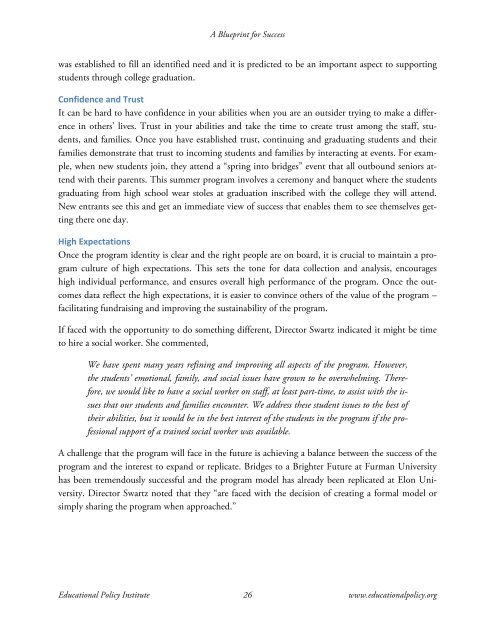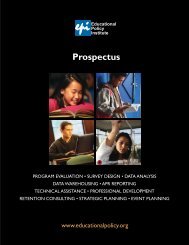A BluePrint for Success: Case Studies of Successful - Educational ...
A BluePrint for Success: Case Studies of Successful - Educational ...
A BluePrint for Success: Case Studies of Successful - Educational ...
You also want an ePaper? Increase the reach of your titles
YUMPU automatically turns print PDFs into web optimized ePapers that Google loves.
A Blueprint <strong>for</strong> <strong>Success</strong><br />
was established to fill an identified need and it is predicted to be an important aspect to supporting<br />
students through college graduation.<br />
Confidence and Trust<br />
It can be hard to have confidence in your abilities when you are an outsider trying to make a difference<br />
in others’ lives. Trust in your abilities and take the time to create trust among the staff, students,<br />
and families. Once you have established trust, continuing and graduating students and their<br />
families demonstrate that trust to incoming students and families by interacting at events. For example,<br />
when new students join, they attend a “spring into bridges” event that all outbound seniors attend<br />
with their parents. This summer program involves a ceremony and banquet where the students<br />
graduating from high school wear stoles at graduation inscribed with the college they will attend.<br />
New entrants see this and get an immediate view <strong>of</strong> success that enables them to see themselves getting<br />
there one day.<br />
High Expectations<br />
Once the program identity is clear and the right people are on board, it is crucial to maintain a program<br />
culture <strong>of</strong> high expectations. This sets the tone <strong>for</strong> data collection and analysis, encourages<br />
high individual per<strong>for</strong>mance, and ensures overall high per<strong>for</strong>mance <strong>of</strong> the program. Once the outcomes<br />
data reflect the high expectations, it is easier to convince others <strong>of</strong> the value <strong>of</strong> the program –<br />
facilitating fundraising and improving the sustainability <strong>of</strong> the program.<br />
If faced with the opportunity to do something different, Director Swartz indicated it might be time<br />
to hire a social worker. She commented,<br />
We have spent many years refining and improving all aspects <strong>of</strong> the program. However,<br />
the students’ emotional, family, and social issues have grown to be overwhelming. There<strong>for</strong>e,<br />
we would like to have a social worker on staff, at least part-time, to assist with the issues<br />
that our students and families encounter. We address these student issues to the best <strong>of</strong><br />
their abilities, but it would be in the best interest <strong>of</strong> the students in the program if the pr<strong>of</strong>essional<br />
support <strong>of</strong> a trained social worker was available.<br />
A challenge that the program will face in the future is achieving a balance between the success <strong>of</strong> the<br />
program and the interest to expand or replicate. Bridges to a Brighter Future at Furman University<br />
has been tremendously successful and the program model has already been replicated at Elon University.<br />
Director Swartz noted that they “are faced with the decision <strong>of</strong> creating a <strong>for</strong>mal model or<br />
simply sharing the program when approached.”<br />
<strong>Educational</strong> Policy Institute 26 www.educationalpolicy.org




